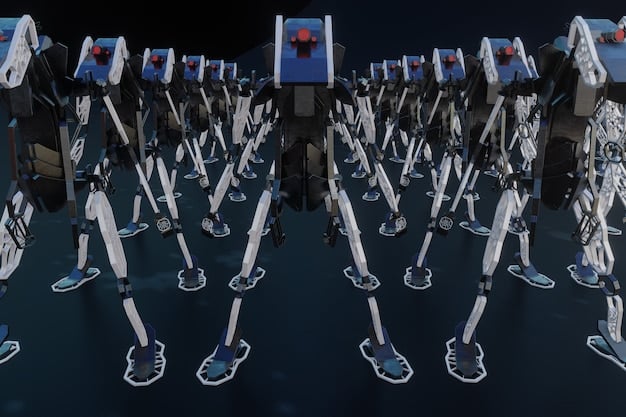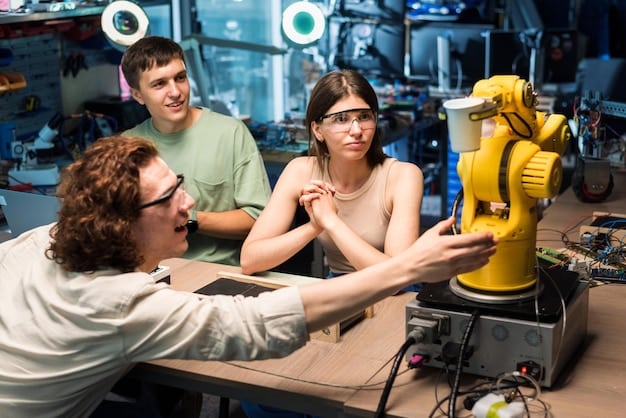US Robotics Competitions: Showcasing the Latest Innovations and Talent

US Robotics Competitions: Showcasing the Latest Innovations and Talent are dynamic arenas where ingenuity, engineering prowess, and collaborative spirit converge, propelling the future of robotics through fierce yet friendly competition and inspiring the next generation of STEM leaders.
Step into the thrilling world of US Robotics Competitions: Showcasing the Latest Innovations and Talent, where bright minds converge to push the boundaries of technology. These events are more than just contests; they are vibrant showcases of engineering brilliance, strategic thinking, and the relentless pursuit of innovation shaping our future. From intricate designs to lightning-fast maneuvers, these competitions offer a unique window into the evolving landscape of robotics.
The evolving landscape of US robotics competitions
The landscape of US robotics competitions has undergone a remarkable transformation over the past few decades, evolving from niche academic pursuits into mainstream spectacles that capture the imagination of millions. What began as small-scale challenges among university students has blossomed into a diverse ecosystem encompassing various age groups, skill levels, and technological focuses. This evolution has been driven by several factors, including advancements in technology itself, increased interest in STEM education, and the compelling nature of competitive robotics.
Initially, these competitions often focused on fundamental engineering principles, tasking participants with building robots that could perform relatively simple functions like line-following or object manipulation. However, as microcontrollers became more powerful, sensors more sophisticated, and manufacturing techniques more accessible, the complexity and ambition of the robots dramatically increased. Today’s competitions demand intricate programming, advanced mechanical design, and sophisticated autonomous capabilities, mirroring the rapid progress seen in the broader robotics industry.
From garage to global arena: a historical overview
The journey of US robotics competitions began modestly, often in university labs or school workshops. Early pioneers like FIRST Robotics Competition, founded in 1989, recognized the potential of competitive events to inspire young people in science and technology. These early competitions laid the groundwork for the robust ecosystem we see today, emphasizing not just technical prowess but also teamwork, gracious professionalism, and problem-solving.
- Early Foundations: Small, localized events with basic robotic tasks.
- Growth and Diversification: Introduction of new competitions catering to different age groups and technical specializations.
- Technological Leap: Rapid advancements in hardware and software enabling more complex robot behaviors.
- Mainstream Recognition: Increased media coverage and corporate sponsorships elevating the profile of these events.
This historical progression highlights a continuous drive to innovate within the competitive framework. Whether it’s the high-stakes, fast-paced challenges of VEX Robotics, the detailed engineering of FIRST, or the specialized tasks of collegiate-level competitions, each iteration brings new complexities and learning opportunities. The consistent goal remains to engage participants actively in design, build, and programming, fostering a deeper understanding of engineering principles through hands-on experience.
The growth in popularity has also led to increased investment from educational institutions and corporations. This funding supports not only the operational aspects of the competitions but also provides resources for teams, such as grants for materials, mentorship programs, and scholarships for participating students. This symbiotic relationship ensures that the competitions remain at the cutting edge, continually attracting new talent and pushing technological boundaries. The emphasis on real-world problem-solving embedded within these events prepares participants for future careers in technology and engineering, making these competitions a crucial pipeline for innovation.
Key players and major events
The US robotics competition scene is vibrant and diverse, powered by several key organizations that host major events throughout the year. These organizations each offer unique challenges and cater to different age groups and skill levels, collectively creating a rich tapestry of competitive opportunities. Understanding these key players and their flagship events is essential to appreciating the breadth and impact of competitive robotics in the United States.
Among the most prominent organizations is FIRST (For Inspiration and Recognition of Science and Technology), a global non-profit that operates multiple robotics programs. Their events are renowned for their scale, complexity, and emphasis on both technical skills and soft skills like teamwork and professionalism. FIRST competitions are often seen as the gold standard, attracting thousands of teams and millions of viewers annually.
FIRST robotics: inspiring innovation and gracious professionalism
FIRST Robotics Competition (FRC) is arguably the most well-known high school robotics competition in the US. Each year, FRC teams are given six weeks to design, build, and program a robot to compete in a game that changes annually. These games are intricate, requiring robots to perform complex tasks such as shooting projectiles, climbing structures, or manipulating objects.
- FIRST Robotics Competition (FRC): High school level, large-scale, complex robots and game challenges.
- FIRST Tech Challenge (FTC): Middle and high school level, smaller robots, more accessible entry point.
- FIRST LEGO League (FLL): Elementary and middle school, uses LEGO Mindstorms, focuses on research projects and core values.
FRC events are characterized by large, arena-style fields, live commentary, and often draw significant crowds. The atmosphere is electric, with teams cheering for each other and demonstrating high levels of sportsmanship, embodying FIRST’s principle of “Gracious Professionalism.” This ethos encourages participants to compete fiercely while treating competitors and partners with respect and kindness, fostering a collaborative yet competitive environment.

Another significant player is the Robotics Education & Competition (REC) Foundation, which oversees the VEX Robotics Competition. VEX is known for its accessibility and modular robot kits, making it a popular choice for schools looking to introduce robotics without extensive prior experience. VEX competitions range from elementary to collegiate levels, emphasizing iterative design and programming.
Collegiate-level competitions, such as the IEEE Robotics Competition and various university-sponsored events, push the boundaries of academic research and advanced engineering. These events often involve highly specialized tasks, drawing participants from top engineering programs across the nation. They serve as critical incubators for future technological breakthroughs, with students developing innovative solutions to complex problems that often have real-world implications.
Collectively, these organizations and their flagship events form the backbone of US robotics competitions. They provide platforms for learning, innovation, and community building, ensuring that a steady pipeline of talented and passionate individuals continues to drive the field of robotics forward. Each competition, while unique in its specifics, shares the common goal of inspiring the next generation of engineers, scientists, and innovators.
Technological innovations showcased
US robotics competitions are not merely about winning; they are dynamic proving grounds for the latest technological innovations. Each season brings new challenges that push participants to explore novel solutions, integrating cutting-edge hardware and sophisticated software. The ingenuity displayed by these young engineers often mirrors, and sometimes even anticipates, trends in the broader robotics industry, from refined sensing capabilities to advanced artificial intelligence.
One of the most evident areas of innovation lies in robot design and fabrication. Teams increasingly leverage advanced manufacturing techniques, such as 3D printing and CNC machining, to create lighter, stronger, and more precise components. This allows for greater mechanical efficiency and the ability to implement intricate mechanisms that were once prohibitively expensive or complex. The shift towards modular design also reflects an industry trend, allowing for quick iteration and repair during often-fast-paced competitions.
AI and machine learning: the brain behind the bot
Beyond mechanical prowess, the true intelligence of these robots often resides in their programming, particularly in the integration of Artificial Intelligence (AI) and Machine Learning (ML). Competitions frequently feature tasks that benefit from complex decision-making, object recognition, and autonomous navigation, pushing teams to delve into advanced software development.
- Advanced Vision Systems: Using cameras and computer vision for object detection and tracking.
- Autonomous Navigation: Implementing algorithms for robots to move independently and efficiently around the field.
- Predictive Analytics: Leveraging data from sensors to anticipate opponent movements or optimize task execution.
- Reinforcement Learning: Training robots to improve performance through trial and error in simulated environments.
For instance, many robots now employ sophisticated vision systems, utilizing cameras and computer vision algorithms to identify game pieces, detect opponents, and accurately aim projectiles. This real-time processing of visual data is critical for achieving high scores in fast-paced game scenarios. Teams experiment with various libraries and neural networks to optimize accuracy and speed, bringing concepts from academic research directly into the competitive arena.
Furthermore, autonomous navigation has become a cornerstone of high-level competition. Robots must often traverse complex fields, avoid obstacles, and reach specific locations without human intervention. This requires robust localization techniques, path planning algorithms, and real-time obstacle avoidance, all aspects where AI and ML play a significant role. The ability of a robot to adapt to unpredictable environments on the fly becomes a major differentiator between top-tier teams.
The competitive nature of these events fosters rapid prototyping and iteration of these technologies. Teams learn to quickly identify shortcomings in their designs or code, implement fixes, and test new solutions under pressure. This agile development cycle is invaluable, mirroring the fast-paced innovation cycles found in leading technology companies. The innovations born on these competition fields often find their way into academic research, industry prototypes, and even consumer products, demonstrating the profound impact of these events on the future of robotics.
Cultivating talent: education and skill development
The true value of US robotics competitions extends far beyond the thrill of victory; they are powerful catalysts for education and unparalleled platforms for skill development. Participating in these events provides a hands-on, project-based learning experience that traditional classroom settings often cannot replicate. From elementary school children building simple LEGO robots to university students engineering complex autonomous systems, the process of designing, building, and programming a robot instills a wide array of invaluable skills.
Perhaps the most obvious benefit is the development of technical proficiency. Students gain practical experience in mechanical engineering, electrical engineering, and computer programming. They learn to use CAD software for design, fabricate parts using various tools, wire circuits, and write code in languages like Python, Java, or C++. This direct application of theoretical knowledge makes abstract concepts tangible and immediately relevant.
More than just code: transferable skills for life
While technical skills are paramount, robotics competitions also foster a wealth of transferable skills that are crucial for success in any field, particularly in collaborative and innovative environments. These are the soft skills that prepare students for leadership roles, effective teamwork, and navigating complex problem-solving scenarios.
- Problem-Solving: Analyzing complex challenges and devising creative, effective solutions under pressure.
- Teamwork and Collaboration: Working effectively in diverse teams, delegating tasks, and resolving conflicts.
- Project Management: Managing timelines, resources, and tasks from conception to completion.
- Communication: Presenting ideas clearly, explaining technical concepts, and providing constructive feedback.
- Resilience and Adaptability: Overcoming setbacks, learning from failures, and adjusting strategies on the fly.
Take problem-solving, for example. When a robot fails to perform as expected during a competition, teams must quickly diagnose the issue, brainstorm solutions, and implement fixes, often with limited time and resources. This iterative process of identifying problems, testing hypotheses, and refining solutions is a core component of engineering and scientific inquiry, and it is honed repeatedly in competitive robotics.
Teamwork and collaboration are also integral. Robotics is inherently a multidisciplinary endeavor, requiring individuals with diverse skill sets to work cohesively towards a common goal. Students learn to delegate tasks, leverage each other’s strengths, communicate effectively, and resolve conflicts constructively. This prepares them for the collaborative nature of modern workplaces, where cross-functional teams are the norm.
Moreover, participants develop strong project management skills. Managing a robotics project involves setting goals, establishing timelines, allocating resources, and tracking progress. From fundraising to outreach, designing prototypes to testing final versions, students get hands-on experience in orchestrating a complex project, preparing them for future entrepreneurial or managerial roles. The pressure cooker environment of competition often brings out the best in these young talents, teaching them to perform under deadlines and adapt to unexpected challenges. This holistic approach to skill development is why robotics competitions are considered foundational experiences for aspiring engineers, innovators, and leaders.
Impact on industry and workforce development
The profound impact of US robotics competitions extends significantly beyond the educational sphere, directly influencing industry and playing a crucial role in workforce development. These events serve as invaluable incubators for future talent, providing a direct pipeline of highly skilled individuals ready to enter various technology and engineering sectors. Companies increasingly look to alumni of these competitions for their practical experience, problem-solving abilities, and collaborative mindset.
Many graduates who participated in competitive robotics during their formative years pursue careers in engineering, computer science, automation, and related fields. They often bring with them not just theoretical knowledge but also hands-on experience with real-world design constraints, project management challenges, and the intricacies of teamwork. This practical foundation gives them a distinct advantage in the job market and allows them to contribute meaningfully from day one.
From competition floor to cutting-edge careers
The skills honed in robotics competitions are highly sought after by modern industries, particularly those at the forefront of technological innovation. The ability to design, build, program, and troubleshoot complex systems in a fast-paced environment directly translates to success in various professional roles.
- Robotics Engineers: Designing and developing new robotic systems for manufacturing, healthcare, and exploration.
- Software Developers: Writing code for embedded systems, AI, and autonomous control.
- Mechanical Designers: Creating innovative physical structures and mechanisms for diverse applications.
- Systems Integrators: Combining different technologies into cohesive and functional systems.
Major tech companies, defense contractors, and manufacturing firms actively scout talent from these competitions. They recognize that individuals who have navigated the challenges of building and competing with robots possess a unique blend of creativity, resilience, and technical acumen. Furthermore, the emphasis on iterative design and rapid prototyping in competitions mirrors agile development methodologies used in industry, ensuring that these individuals are well-prepared for real-world engineering challenges.

Beyond individual career paths, the competitions also foster a broader culture of innovation that benefits the entire industry. They encourage experimentation and the adoption of new technologies, propelling research and development forward. The specialized knowledge gained in specific competition challenges often leads to the development of new techniques or tools that can be applied to industrial problems.
Moreover, the competitions help to demystify robotics and STEM fields, attracting a more diverse pool of talent. By engaging students from various backgrounds and demonstrating the exciting possibilities within robotics, these events are helping to broaden participation in technical careers, addressing critical workforce shortages in high-demand areas. In essence, US robotics competitions are not just developing better robots; they are cultivating the highly skilled workforce that will drive the next wave of industrial innovation and technological advancement.
Challenges and future outlook
Despite their undeniable success and significant impact, US robotics competitions face a unique set of challenges as they look toward the future. Addressing these hurdles will be crucial for maintaining their relevance, accessibility, and ability to continue fostering innovation and talent development. These challenges range from ensuring equitable access to resources to adapting to new technological paradigms.
One of the primary challenges is financial accessibility and resource disparity. While many organizations strive to make robotics reachable for all, the cost associated with building competitive robots, traveling to events, and acquiring necessary equipment can be substantial. This often creates an unequal playing field, with well-funded schools and teams having a distinct advantage over those from underprivileged communities. Bridging this gap requires ongoing efforts in fundraising, sponsorships, and providing grants.
Ensuring accessibility and fostering diversity
To truly democratize robotics education, it’s imperative to address the barriers that prevent broader participation. This includes not only financial constraints but also access to mentors, technical facilities, and educational resources. Future initiatives must focus on ensuring that students from all backgrounds have the opportunity to engage with competitive robotics, fostering diversity in STEM.
- Funding and Sponsorships: Increasing grants and corporate support to lower participation costs.
- Outreach Programs: Expanding mentorship and training initiatives in underserved communities.
- Modular and Affordable Kits: Developing more cost-effective robot kits and open-source resources.
- Inclusivity Initiatives: Actively encouraging participation from underrepresented groups in STEM.
Another significant challenge lies in keeping pace with the rapid advancements in robotics technology. Competition organizers must continually evolve game rules and challenges to remain relevant and stimulating, pushing the boundaries of what participants can achieve. This requires staying abreast of emerging technologies like advanced AI algorithms, new sensor modalities, and sophisticated actuation systems, integrating them into future challenges in a meaningful way.
Looking ahead, the future of US robotics competitions is likely to be characterized by several key trends. We can expect an even greater emphasis on autonomous capabilities, perhaps with increasingly complex AI challenges. The integration of virtual reality (VR) and augmented reality (AR) for simulation, training, and remote participation could also become more commonplace, expanding opportunities for engagement.
There will also be a continued focus on demonstrating real-world applicability. Future competitions may increasingly task robots with solving problems directly relevant to societal needs, such as environmental monitoring, disaster response, or healthcare automation. This shift would not only make the competitions more engaging but also highlight the tangible benefits of robotics to a broader public. Ultimately, by proactively addressing current challenges and embracing future trends, US robotics competitions can continue their vital role in showcasing innovation, cultivating talent, and inspiring the next generation of technological leaders.
The competitive spirit and community building
Beyond the technical prowess and innovation, an equally crucial element underpinning the success and enduring appeal of US robotics competitions is the vibrant competitive spirit intertwined with a profound sense of community building. These events are not just about who builds the best robot; they are about fostering camaraderie, sportsmanship, and a shared passion for engineering that extends far beyond the competition field.
The competitive nature encourages teams to push their limits, innovating under pressure and striving for excellence. The palpable tension and excitement during matches drive participants to perfect their designs, refine their programming, and execute strategies flawlessly. This pursuit of victory, however, is often tempered by a unique ethos of “gracious professionalism” or “coopertition,” where teams compete fiercely but respectfully, often helping their rivals solve issues or lending parts.
Beyond the scoreboard: friendships and networks
While the glory of winning a trophy is a powerful motivator, many participants argue that the most significant takeaways from robotics competitions are the relationships built and the community forged. These events become melting pots for like-minded individuals, fostering friendships, mentorships, and professional networks that can last a lifetime.
- Mentorship Opportunities: Experienced engineers guiding younger students, fostering knowledge transfer.
- Peer Collaboration: Teams sharing strategies, code, and mechanical designs to collectively improve.
- Networking Events: Opportunities for students to connect with industry professionals and academics.
- Shared Experiences: Overcoming challenges and celebrating successes together, building lasting bonds.
The community aspect is particularly evident during the events themselves. Pits are often open, allowing teams to visit one another, share ideas, and even offer assistance with last-minute repairs. This collaborative atmosphere, even among competitors, is a defining characteristic of robotics competitions and creates a supportive ecosystem where learning and growth are prioritized over mere victory.
For many students, these competitions are their first exposure to a large-scale technical community. They learn the value of effective communication within their own teams and with alliance partners. The collaborative problem-solving that occurs during matches, where robots from different teams must work in concert to achieve common objectives, further reinforces the importance of interpersonal skills alongside technical ones.
Furthermore, the spirit of competition extends to inspiring others. Teams often engage in outreach programs, visiting local schools or community events to demonstrate their robots and encourage younger students to get involved in STEM. This cycle of inspiration ensures a continuous influx of new talent into the robotics community, perpetuating its growth and impact. The blend of intense competition and supportive community makes US robotics competitions profoundly transformative experiences, equipping participants not just with technical skills but also with the social and ethical frameworks necessary for future leadership in a collaborative world.
| Key Aspect | Brief Description |
|---|---|
| 🚀 Innovation Showcase | Competitions are vital platforms for new robotics tech, from advanced AI to optimized mechanics. |
| 📚 Skill Development | Participants gain critical STEM, teamwork, and problem-solving abilities. |
| 🌐 Industry Impact | Competitions serve as a talent pipeline, connecting students with leading tech companies. |
| 🤝 Community & Spirit | Fosters collaboration, sportsmanship, and lasting relationships among participants. |
Frequently asked questions
▼
US robotics competitions are organized events where teams design, build, and program robots to complete specific tasks or challenges. They range from elementary school to collegiate levels, focusing on different aspects of robotics and engineering skills. These events foster innovation, teamwork, and problem-solving, inspiring participants in STEM fields.
▼
Key organizers include FIRST (For Inspiration and Recognition of Science and Technology), which runs programs like FRC and FTC, and the Robotics Education & Competition (REC) Foundation, known for the VEX Robotics Competition. Various universities and professional organizations also host specialized collegiate-level events across the country.
▼
Innovations span various areas, including advanced robot design and fabrication using 3D printing, sophisticated AI and machine learning for autonomous navigation and vision systems, and novel programming techniques. These competitions often serve as testing grounds for technologies that later find applications in industrial and commercial robotics.
▼
Participants develop a wide range of technical skills in mechanical design, electrical engineering, and programming. Crucially, they also hone essential transferable skills such as problem-solving, project management, teamwork, communication, and adaptability. This hands-on experience is invaluable for future academic and professional pursuits.
▼
These competitions act as a vital pipeline for skilled talent into technology and engineering sectors, from software development to specialized robotics engineering. Industries actively recruit participants due to their practical experience and collaborative skills. The events also foster innovation and help diversify the STEM workforce across the US.
Conclusion
US robotics competitions undeniably stand as critical pillars in the nation’s technological advancement and educational landscape. They are vibrant ecosystems where innovation is ignited, talent is meticulously cultivated, and the vital skills necessary for the future workforce are honed. By providing challenging, hands-on experiences, these events prepare a generation of problem-solvers, engineers, and collaborators. Their continued evolution, coupled with a persistent focus on accessibility and diversity, ensures that the spirit of invention and the pursuit of excellence will continue to thrive, propelling the United States into a future defined by groundbreaking robotic achievements.





